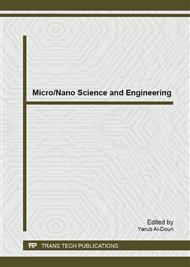[1]
Information on http: /www. oulu. fi/spareparts/ebook_topics_in_t_e/abstracts/fisher_1. pdf.
Google Scholar
[2]
K. Vassilis, K. David, Porosity of 3D biomaterial scaffolds and osteogenesis, Biomaterials. 26 (2005) 5474-549.
DOI: 10.1016/j.biomaterials.2005.02.002
Google Scholar
[3]
Z.C. Qizhi, D.T. Ian, R.B. Aldo, 45S5 Bioglass – derived glass ceramic scaffolds for bone tissue engineering, Biomaterials. 27 (2006) 2414-2425.
DOI: 10.1016/j.biomaterials.2005.11.025
Google Scholar
[4]
J. S. Antonio, P. C. Olga, L. R. Rui, Bone Tissue Engineering: State of the art and future trends, Macromol. Biosci. 4 (2004) 743-765.
Google Scholar
[5]
K. Rezwana, Q.Z. Chena, J.J. Blakera, A. R. Boccaccini, Biodegradable and bioactive porous polymer/inorganic composite scaffolds for bone tissue engineering, Biomaterials. 27 (2006) 3413–3431.
DOI: 10.1016/j.biomaterials.2006.01.039
Google Scholar
[6]
V. Maquet, A.R. Boccaccin, L. Pravata, I. Notingher, R. Jérôme, Porous poly ([alpha] hydroxyacid)/Bioglass scaffolds for bone tissue engineering. I: preparation and in vitro characterization, Biomaterials. 25 (2004) 4185-4194.
DOI: 10.1016/j.biomaterials.2003.10.082
Google Scholar
[7]
L. I. Susan, M. C. Genevieve, J. Y. Michael, G. M. Antonios, Three-dimensional culture of rat calvarial osteoblasts in porous biodegradable polymers, Biomaterials. 19 (1998) 1405-1412.
DOI: 10.1016/s0142-9612(98)00021-0
Google Scholar
[8]
V. Guarino, F. Causa, L. Ambriosio, Bioactive scaffolds for bone and ligament tissue, Expert Rev Med Dev. 4 (2007) 405-418.
DOI: 10.1586/17434440.4.3.405
Google Scholar
[9]
Information on http: /www. oulu. fi/spareparts/ebook_topics_in_t_e_vol4/abstracts/q_chen. pdf.
Google Scholar
[10]
J. Wilson, G.H. Pigot, F.J. Schoen, L.L. Hench, Toxicology and biocompatibility of bioglass, J Biomed Mater Res. 15 (1981) 805-811.
Google Scholar
[11]
A.M. Gatti, G. Valdre, O.H. Andersson, Analysis of the in vivo reactions of a bioactive glass in soft and hard tissue, Biomaterials. 15 (1994) 208-212.
DOI: 10.1016/0142-9612(94)90069-8
Google Scholar
[12]
A.E. Clark, L.L. Hench, Calcium phosphate formation on sol gel derived bioactive glass, J Biomed Mater Res. 28 (1994) 693-698.
DOI: 10.1002/jbm.820280606
Google Scholar
[13]
H. Takadama, T. Kokubo, How useful is SBF in predicting in vivo bone bioactivity, Biomaterials. 27 (2006) 2907-2915.
DOI: 10.1016/j.biomaterials.2006.01.017
Google Scholar
[14]
C.Q. Chen, A.R. Boccaccini, Poly (D, L-Lactic acid) coated 45S5 Bioglass®based scaffolds: processing and characterization. Journal of Biomedical Materials Research. Part A 77A (2006) 445-457.
DOI: 10.1002/jbm.a.30636
Google Scholar
[15]
F. Paola, C. Valeria, S. Antonella, D. Andrea, C. Federica, Highly porous polycaprolactone-45S4 bioglass scaffolds for bone tissue engineering, Composites Science and Technology. 70 (2010) 1869-1878.
DOI: 10.1016/j.compscitech.2010.05.029
Google Scholar
[16]
M.D. Yunos, O. Bretcanu, A.R. Boccaccini, (2008), Polymer-Bioceramic composite for tissue engineering, Journal of Material Science. 43 (2008) 4433-4442.
DOI: 10.1007/s10853-008-2552-y
Google Scholar
[17]
D.C. Clupper, J.J. Mecholsky Jr., G.P. LaTorre, D.C. Greenspan, (2001), Sintering temperature effects on the in vitro bioactive response of tape cast and sintered bioactive glass-ceramic in Tris-buffer, J. Biomed Mater Res. 57 (2001) 532-40.
DOI: 10.1002/1097-4636(20011215)57:4<532::aid-jbm1199>3.0.co;2-3
Google Scholar


